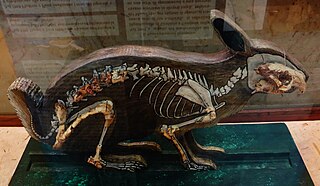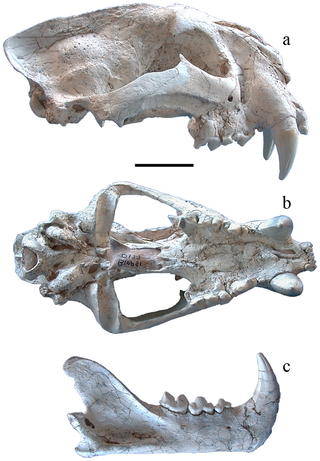
Otters are carnivorous mammals in the subfamily Lutrinae. The 13 extant otter species are all semiaquatic, aquatic, or marine. Lutrinae is a branch of the Mustelidae family, which includes weasels, badgers, mink, and wolverines, among other animals.

Rails are a large, cosmopolitan family of small- to medium-sized terrestrial and/or semi-amphibious birds. The family exhibits considerable diversity in its forms, and includes such ubiquitous species as the crakes, coots, and gallinule; other rail species are extremely rare or endangered. Many are associated with wetland habitats, some being semi-aquatic like waterfowl, but many more are wading birds or shorebirds. The ideal rail habitats are marsh areas, including rice paddies, and flooded fields or open forest. They are especially fond of dense vegetation for nesting. The rail family is found in every terrestrial habitat with the exception of dry desert, polar or freezing regions, and alpine areas. Members of Rallidae occur on every continent except Antarctica. Numerous unique island species are known.

Junglefowl are the only four living species of bird from the genus Gallus in the bird order Galliformes, and occur in parts of South and Southeast Asia. One of the species in this genus, the red junglefowl, is of historical importance as the direct ancestor of the domestic chicken, although the grey junglefowl, Sri Lankan junglefowl and green junglefowl are likely to have also been involved. The Sri Lankan junglefowl is the national bird of Sri Lanka. They diverged from their common ancestor about 4–6 million years ago. Although originating in Asia, remains of junglefowl bones have also been found in regions of Chile, which date back to 1321–1407 CE, providing evidence of possible Polynesian migration through the Pacific Ocean.

The Pantherinae is a subfamily of the Felidae; it was named and first described by Reginald Innes Pocock in 1917 as only including the Panthera species, but later also came to include the clouded leopards. The Pantherinae genetically diverged from a common ancestor between 9.32 to 4.47 million years ago and 10.67 to 3.76 million years ago.

Grus is a genus of large birds in the crane family.

Panthera palaeosinensis was an early Pleistocene species from northern China. It is often incorrectly referenced as the ancestor of the tiger, Panthera tigris, although it shares features with all living large cats. Recent studies place it close to the base of the genus Panthera.

Rallus is a genus of wetland birds of the rail family. Sometimes, the genera Lewinia and Gallirallus are included in it. Six of the species are found in the Americas, and the three species found in Eurasia, Africa and Madagascar are very closely related to each other, suggesting they are descended from a single invasion of a New World ancestor.

Porzana is a genus of birds in the crake and rail family, Rallidae. Its scientific name is derived from Venetian terms for small rails. The spotted crake is the type species.

Hypolagus is an extinct genus of lagomorph, first recorded in the Hemingfordian of North America. It entered Asia during the early Turolian and spread to Europe not much later, where it survived until the Middle Pleistocene. Though unknown in the Iberian Peninsula, fossils of this genus have been found in the Balearic Islands, suggesting an eastern migration during the dry period in the Mediterranean region known as the Messinian Salinity Crisis.

Fallow deer is the common name for species of deer in the genus Dama of subfamily Cervinae.

Panthera zdanskyi is an extinct pantherine species, the fossils of which were excavated in Gansu Province, northwestern China. Due to its close relationship with the modern tiger, it is called the Longdan tiger.

The Petralona Cave a karst formation, is located at 300 m (984 ft) above sea-level on the western foot of Mount Katsika, about 1 km (0.62 mi) east of the village of Petralona, about 35 km (22 mi) south-east of Thessaloniki city on the Chalkidiki peninsula, Greece. The site came to public attention when in 1960 a fossilized archaic human skull was found. The cave had been discovered accidentally only a year earlier (1959) after erosion had left clefts in the rock. "Bejeweled" with impressive stalactite and stalagmite formations and holding an abundance of fossils, the cave soon attracted geologists and paleontologists. After decades of excavations the cave is open to the public and scientific work is documented and presented in an adjacent archaeological museum.

Soergelia is a genus of extinct ovibovine caprine that was common across Europe, North America and Asia in the Pleistocene epoch.

Pseudodama is an extinct genus of deer found in Europe during the Late Pliocene to Early Pleistocene. It has been suggested by some authors to be ancestral to Dama, with some authors choosing to subsume its species into that genus.

Zapornia is a recently revalidated genus of birds in the rail family Rallidae; it was included in Porzana for much of the late 20th century. These smallish to tiny rails are found across most of the world, but are entirely absent from the Americas except as wind-blown stray birds. A number of species, and probably an even larger number of prehistorically extinct ones, are known only from small Pacific islands; several of these lost the ability to fly in the absence of terrestrial predators. They are somewhat less aquatic than Porzana proper, inhabiting the edges of wetlands, reedbelts, but also drier grass- and shrubland and in some cases open forest.

Sibirionetta is a genus of dabbling duck which contains two species, an extant species Baikal teal and the fossil species Sibirionetta formozovi from the early Pleistocene of Baikalian Siberia.
Panthera shawi is an extinct prehistoric cat, of which a single canine tooth was excavated in Sterkfontein cave in South Africa by Robert Broom in the 1940s. It is thought to be one of the oldest known Panthera species in Africa.
Titanoperdix is an extinct monospecific genus of landfowl, belonging to the Phasianidae family. It was related to the modern grey partridge, although it was substantially larger, reaching the size of the modern black grouse. Its fossilized remains were discovered in Early Pleistocene deposits, near Malye Goly, in Irkutsk Oblast, in Eastern Siberia.















